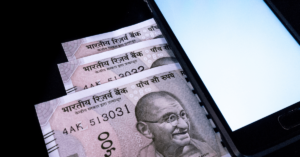Millennials and Gen Z – the digitally native generations – have spent almost their entire lives surrounded by computers and mobile devices and social media, leading to a drastic change in consumer behaviour. India’s mobile revolution in the country coupled with low data prices has changed the entertainment for the younger generations.
For years, the television industry in India was playing a monotonous tone, whereas the West moved to “Binging on Netflix”. Recently, however, the urban gentry which fed on western media on the internet started making a staggering move to buying subscription plans when Netflix launched in India. Then the COVID wave hit us and how! Surprisingly again, India adapted to the new concept.
The global OTT (over-the-top) market revenue is expected to reach over $205,565 million in 2022 with India contributing to over $2,673 million. With a CAGR (compound annual growth rate) of 10.10 percent, the market is expected to reach over $3,928 million by 2026. This makes India the second most crucial market after China’s projected revenue of $63,106 million by the year 2026.
The immense popularity of OTT in India owes its success to the rapid adoption and evolution of internet infrastructure that helps platforms to deliver content directly to the viewers, bypassing traditional distribution and media networks. The vast variety spoils the audience by providing them with the flexibility to choose the content they want to consume and the time at which they want to access it.
With this, let’s take a look at how OTT is constantly changing the dynamics of the media industry.
OTT platforms help build a direct connection with customers
Initially, broadcasters used to rely heavily on traditional distribution methods like cable and DTH platforms. The advent of OTT media streaming has made it easier and more convenient for broadcasters to directly showcase their content to customers.
This helps build a direct relationship with the users on the OTT platform. It also helps them create a strong brand image and improves brand recall. In addition to showcasing content directly, broadcasters can also obtain detailed insights about how users are interacting with their content with the help of big data and analytics. This data-driven approach helps them churn out better content, especially that is tailored to their customers’ preferences.
OTT platforms pushing boundaries
Given the high mobile broadband penetration in the country, the mobile phone has become one of the most widely used streaming devices in India. Being the second-largest consumer base in the world, India serves as a battleground for even already established entities. For instance, Netflix India has a mobile-only Rs149/- per month plan.
A dynamic market like India not only makes for the biggest playground for corporates but also makes for a solid statistical data set developer that comprises a truly wide range of consumers for data harnessing.
Seamless content viewing experience across multiple devices
One of the most pronounced reasons the OTT industry is making advances in how they provide their services is because of the hugely improved customer user experience (UX) that they offer. One of the ways of achieving this is offering a seamless content viewing experience over a variety of devices and platforms.
A seamless viewing experience across multiple devices and platforms is a must-have for OTT platform owners who want to build a sustainable following and audience base. A multi-screen OTT experience is another crucial factor that has helped the streaming industry to gain an ever-growing customer base. Sadly, a traditional cable network can barely cut the mustard.
OTT is the top option for advertisers and marketers
With a total ad spend for OTT platforms forecasted to exceed $300 billion and the global ad market over $700 billion, OTT becomes a top priority for advertisers to shift focus towards these entertainment mediums.
Furthermore, as the popularity of OTT platforms keeps on growing, advertisers would want to explore these neo ad revenue channels to showcase their products and obtain quality traffic and suitable audience growth. This helps to increase their marketing ROIs and also leads to higher conversion rates based on user behaviours and preferences.
OTT has led led to more cord-cutting
With the exponential growth of OTT video streaming, the competitive dynamics of the OTT vs pay-TV war have has changed greatly. The most obvious losers due to these tectonic shifts in content consumption are traditional broadcasters and cable TV operators.
Cable TV operators are losing subscribers because of high prices and lack of comparable choices leading to the phenomenon known as “cord-cutting” that has made drastic changes in the broadcasting market. India reported nearly 69 million active subscribers of direct-to-home or DTH television as of September 2021, a steady decrease from a 103 million subscriber base in December 2020.
While India has a 100 percent digital cable television network due to its mandatory regulation, the rising OTT market along with the impact of the COVID-19 pandemic, seem to harm the monopoly of cable television in the country. This decline is further amplified by the increasing costs of cable subscriptions in comparison to their streaming counterparts.
OTT opened the world for creators
All around the world, there was never a dearth of good creators. The platform for which was not available with stringent laws of airing content slapped on traditional TV.
OTT became the pallbearer of production houses and broadcasters that believed in a more inclusive content showcasing.
Not just creators, erstwhile artists who lost their relevance due to a shift in the kind of entertainment have found their place in the limelight again. As an example, web series like Aryaa featuring Sushmita Sen, Aranyak featuring the yesteryear heartthrob Raveen Tandon Thadani and more recently launched Fame Game featuring Madhuri Dixit Nene, India’s evergreen face of Bollywood, have opened to applause and excitement.
Visual content truly went global with OTT when the content of the East found takers and did business in the west without any exclusions or viewing hurdles like language etc, and vice versa. It gave the industry a much-needed boost. OTT achieved that by feature enhancements that led to a seamless change in audio and closed caption facilities for ease of consumption in non-local areas.
It also helped boost revenue generation of independent creators and production houses by opening the door of using licenced music by partnering with social media giants. For instance, big production houses like SaReGaMa.Shemaroo and Eros Entertainment are now licensing music to platforms like Instagram and Youtube to be used in Reels and Shorts ( short form vertical videos).
DTH TV operators joining hands with OTT
The constantly increasing numbers of cord-cutters have led to the downfall in revenue for DTH TV operators, who are now seeking innovative ways to lure back their viewers. Due to the immense popularity of video streaming amongst millennials, traditional TV and film giants are now seeking to join Netflix and Amazon.
While companies like Reliance Jio and Airtel are trying to lure in customers with their bundle offering of OTT platforms along with their STB units, other players like Tata Sky have joined hands with Amazon Firestick to launch co-branded streaming devices that offer consumers to watch a variety of digital content from various OTT platforms through a single subscription plan.
With OTT platforms forming our habit of daily drivers of entertainment, strategic partnerships of DTH operators with OTT platforms will further drive the growth of the Indian entertainment industry with more such OTT combo models. It’s time for foes to befriend their enemy.
OTT is powering emerging technologies
As emerging OTT video technologies are using artificial intelligence (AI) to enhance the customer experience. By using AI to determine what customers want to watch, OTT service providers can earn more revenue and deliver more personalised experiences to retain customers. An excellent example of this, Netflix revealed that it has saved $1 billion a year with AI technologies.
Also, emerging technologies like 5G synonymous with high speed and ubiquitous connectivity will ensure OTT experiences like never before that don’t keep buffering, lag annoyingly, or unwanted pixelation. 5G powered OTT will also give a massive boost to both live streaming and VoD segment with its 10X decrease in end-to-end latency, 20X faster speed, and higher bandwidth.
Wrapping up
Change of broadcasting preferences of production houses are glaring and that availability of choice will continue to bring more changes in the way that content is created and distributed for the masses. The content creator community has realised the importance of jumping in to ride on this wave fearing further loss in this ongoing war between Pay TV vs OTT.
Going by this uptrend, I believe that the OTT video streaming industry will provide new opportunities for broadcasters and cable providers to grow their reach. With viewership gradually escalating on the OTT side, broadcasters must not miss this golden opportunity of directly showcasing their offerings to their audiences unless they want to lose it in the long run.
(Disclaimer: The views and opinions expressed in this article are those of the author and do not necessarily reflect the views of YS.)










